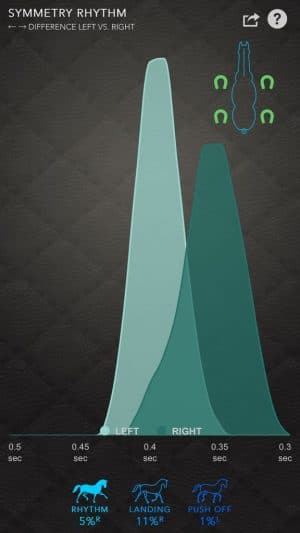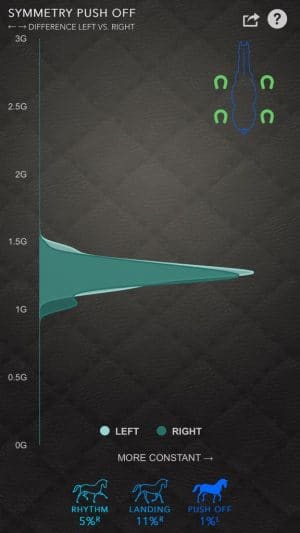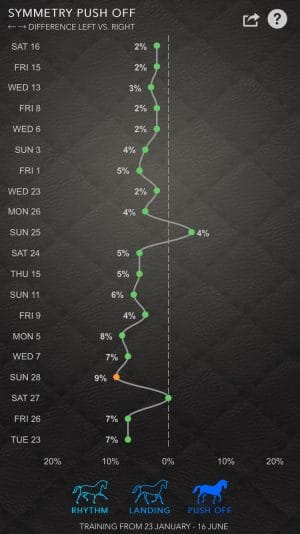The symmetry analysis functionality of the Equestic SaddleClip has changed as of app version 1.3.1. We expanded from one to three separate measurements.
In recent months we have been able to refine the measurements to a higher level and we can now separate the symmetry into three measurements:
- Timing difference based on foot-on and foot-off
- Difference in push-off power
- Difference in impact on landing
This gives much more insight into the symmetry and offers even more possibilities to consciously and effectively train your horse.

Why is symmetry so important?
Symmetry is a good indicator of straightness and well-being (physical condition) of the horse and has a great influence on the quality of training. More symmetry means:
- Better rhythm
- Healthier movement
- Better performance in all disciplines
- More print and thus a larger moment of suspension
- The horse is better able to carry the rider and the rider can therefore sit more easily and better
- Less riding problems, the horse can focus better and handle exercises better
- Less stress and less chance of injuries in the horse
What types of symmetry does the SaddleClip distinguish?
The symmetry measurements are all done in trot. The trot is a symmetrical two-beat movement in which the diagonal leg pairs alternatively push-off and land with a moment of suspension inbetween. We analyse symmetry in Rhythm, Push-off and Landing.

Rhythm
How do the diagonal legs move in relation to each other? Are they moving in the same rhythm? Do they have the same timing?
Symmetry of the Rhythm is comparison of the duration of diagonal steps in trot.
Each step is the time from hooves pushed off the ground – until the last millisecond of hooves staying on the ground before the next push-off. One step of the diagonal is including all stages of the two legs move.
In the screenshot the step time of the left diagonal is slightly slower than that of the right diagonal.
The graph of the left diagonal is also slightly higher and narrower than the other. This means that the left diagonal is slightly more consistent in its timing than the right diagonal.

Landing
How heavily does your horse land on one or the other diagonal? Does your horse position its weight more on one diagonal?
In the screenshot shown, the horse lands harder on the right diagonal (the graph is higher) and softer on the left.The graph of the left diagonal is also slightly longer and narrower than the other. This means that the left diagonal is more consistent in its landing than the right.

Push off
How hard do the diagonals push off from the ground in relation to each other? Are they equally strong?
In the screenshot shown, it is almost exactly the same for both diagonals. Excellent! We do not see this often, this is what we strive for!
How to use symmetry analysis?
Possible causes of deviation in the symmetry can be very diverse. The analysis of the SaddleClip show the facts, but are not a diagnosis of the cause. For that, it is wise to consult with an expert trainer. Possible causes can be:
• Natural skewness horse / crooked horse
• Influence of the rider: Seat, leg, hand
• Influence of tack: bad fitting or crooked saddle, bridle or bit
• Other inconveniences in the horse, for example, blockages or injuries
Which exercises or adjustments can be made to improve the symmetry depends on the possible causes and available solutions. Here too, we advise consultation with an expert trainer.

Monitor progress!
Progress and the effect of training adjustments can easily be monitored with the SaddleClip.
With the overviews as shown, you can see at one glance how each symmetry develops over a longer period.
The push-off of this horse is clearly becoming more symmetrical. Well done!





